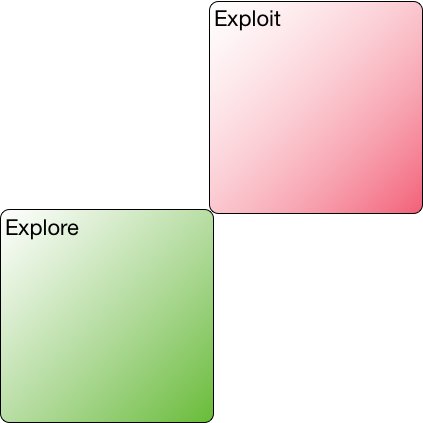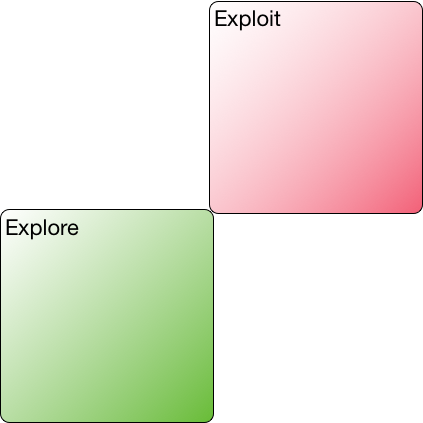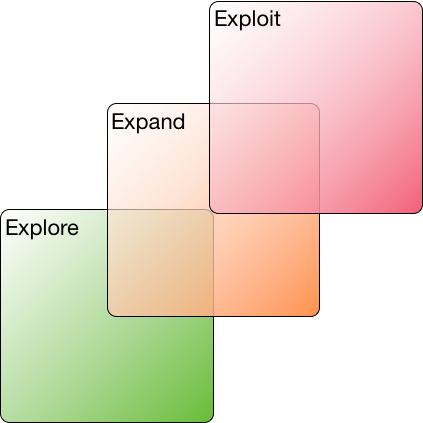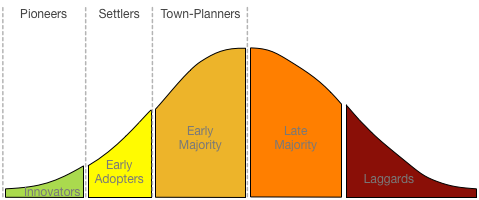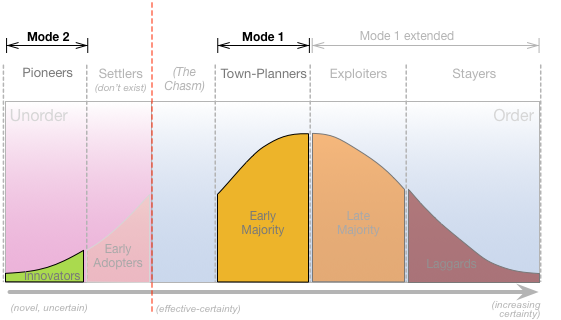Explore, expand, exploit
Blog: Tom Graves / Tetradian
It seemed straightforward enough as a description of the development process: explore, then exploit.
(I forget which book we saw this in: one of Alex Osterwalder’s, I think, but I’m not sure.)
Explore, to find out what the requirements are, how to do it, run up a few prototypes, build the final deliverable – that sort of thing.
Then exploit, to make full, practical use of what we’ve developed. Maybe throw in a few tweaks and updates along the way, but the focus is on use. ‘Sweat the assets’ and suchlike.
And often, different people, different teams, running each of those stages. With a distinct handover between them, where the two stages touch.
Again, it all seemed straightforward enough, whilst I was talking it through the other day with Peter Cumper, one of my Australian enterprise-architecture colleagues.
But then it hit us: it’s exactly the same as the ‘Bimodal-IT’ mistake. ‘Explore’ as Bimodal’s agile-style ‘Mode 2’, and ‘Exploit’ as the production-oriented ‘Mode 1’.
Which, if we cross-reference it to Simon Wardley’s critique ‘Bimodal IT – the new old hotness‘, implies that there’s a whole section missing from that Explore/Exploit model – a section that would align to the ‘Settlers’ in Wardley’s three-stage ‘Pioneers, Settlers, Town-Planners’ model.
Use the term ‘Expand‘ to describe that missing step, linking between Explore and Exploit, and overlapping each in a way that links them together:
In that sense (if with some provisos), it also lines up well with the first three stages of classic Rogers technology-adoption sequence:
Rogers’ Innovators line up quite well with Wardley’s Pioneers, and the Explore mode here: they each deal with the new, or with creating the new.
Rogers’ Early Majority line up quite well with Wardley’s Town Planners, and the Exploit mode here: they each deal with making the best and most efficient use of something that already exists.
And between those two focus-areas, we have Rogers’ Early Adopters, or Wardley’s Settlers, or the Expand mode here: they each deal with making the new usable and useful.
But exactly as Simon Wardley warns about the absence of the Settlers, if the Early Adopters are missing, there’s a great big gap that can’t easily be bridged:
In which case, what would it look like if that intermediate Expand stage is missing? Conversely, what is it that happens in that Expand stage?
The short-answer is that, like Rogers’ Early Majority, the skills in use in the Expand phase are those that take a new idea make it work. The Explore phase produces a prototype; but that isn’t going to work well for Exploit – too unstable, too unreliable, often too inefficient, too fragile for real-world use. For one example that Peter Cumper and I discussed, Explore produces a rough-but-working prototype, which Expand reworks with cloud-services to deal with the scaling issues, privacy issues, compliance concerns and and more – giving a scalable, reliable production-ready tool that Exploit can, well, exploit.
And as shown in that diagram, there’s a cross-over here. The Expand phase starts not at the end of Explore, but about halfway through; it then guides the handover to Exploit, until the latter fully takes over at, again, around the respective halfway-point:
The key point here is that the mindsets and skillsets are different in each phase. Sure, we’ll always get some cross-over between them – again, as in that diagram above – but overall they’re not interchangeable, and we do need them all.
So, a question for enterprise-architects: In your organisation and its change-management processes, what support do you have for all three of these distinct change-domains – Explore, Expand and Exploit? And if your organisation has been afflicted by the Bimodal bug, what do you need to do, to provide the support needed to bridge that gap? – or at least to bring about the awareness that it’s a gap that needs to be bridged?
Over to you for your comments and experiences, anyway.
Leave a Comment
You must be logged in to post a comment.
